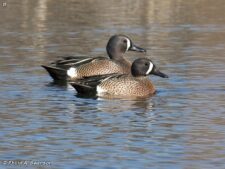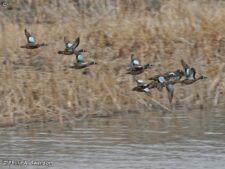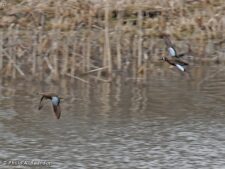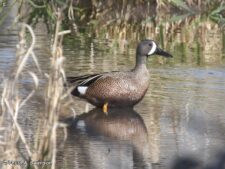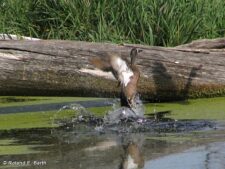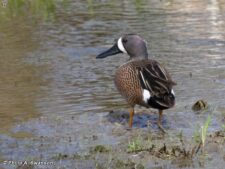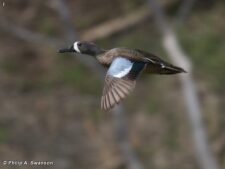
15.5 inches long with a wingspan of 23.0 inches. The Blue-winged Teal is a small dabbling duck with pale blue upper wing patch. There is a green speculum with a white leading edge. The breeding male has a blue-gray head with a large white crescent on the face in front of the eye. There is a dark cap on the head. The breast and flanks are buff with dark spots. The undertail is black. There is a triangular white patch at the rear portion of the flanks. Breeding plumage is worn from early winter through early summer. The female has a mottled body with a darker back. The head is pale with a dark crown and eye line. She has a pale eye ring and a light spot in front of her eye.
The Blue-winged Teal is a common breeder in the Forest. It is best seen in the Great Marsh and along Stream Trail. It is one of the later arriving ducks that can be expected to show up mid March. They also leave early and are gone by the end of September although some may straggle until November.
Like other small dabbling ducks that breed in North America, Blue-winged Teal pair in late winter or as they begin northern migration in spring. As with most ducks, females tend to return to the same breeding regions more than males. Upon arrival on breeding areas, a female selects a territory that her mate strongly defends until late incubation. Females generally nest in upland vegetation. Most young fledge in late July or early August. Adult males also begin southern migration well ahead of females and juveniles. Blue-winged Teal feed by swimming in shallow water with the bill outstretched, picking seeds and vegetation from the surface. The male call given during display is a high, thin, whistled “peew”. The female has a hoarse “quack”.
Disclaimer: The content of NatureSearch is provided by dedicated volunteer Naturalists of Fontenelle Forest who strive to provide the most accurate information available. Contributors of the images retain their copyrights. The point of contact for this page is: Phil Swanson.

